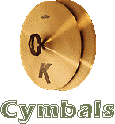Cymbals
Cymbals
Contents :
History
Cymbals have been used in religious ceremonies since ancient times. They are thought to be of Asiatic origin. Different forms of the cymbals were used in the ancient East. They were in use in Isreal by about 1100 B.C., but they did not appear in Egypt until around 800 B.C.
They have been known in Europe since the Middle Ages.
Cymbals were traditionally produced in Turkey and China. They were made two different ways. One method was producing an almost flat cymbal, and the other contained a high central dome.
Small finger cymbals were also made. They have a bell-like tone and are still used today.
Cymbals appeared intermittently in Europe from the 13th century on, although they are believed to have been imported earlier. Their orchestral debut was in the 17th century, but they did not last.
Turkish military music contained cymbals parts during the 18th century. This aided in the introduction of the cymbals into the orchestra. They gained a permanent position during the late part of the century.
Top
Description
The cymbals are a percussion music instrument. They consist of two thin, round, concave plates of copper-tin alloy. They typically have handles or leather things attached to their backs. The modern orchestral cymbal is at least 14 inches in diameter.
Sometimes a single cymbal may be suspended from a frame with a petal-actuated cymbal underneath. This is called a choke cymbal. The opposite of this is a sock cymbal, where the top is fixed and the bottom cymbal is moveable.

Top
Sound Production
Sound is produced by clashing together the cymbals or striking them separately with hard or soft beaters. The cymbals are struck together with a brushing motion because clashing them directly together may cause them to crack. This produces a long-lasting loud or soft sound of indeterminate pitch.
A cymbal suspended from a frame produces sound either by a petal- actuated cymbal or by metal brushes or a cloth-covered drumstick.
